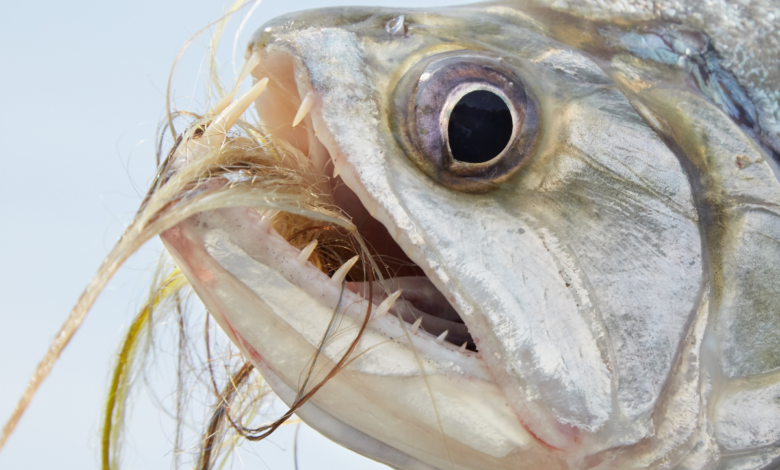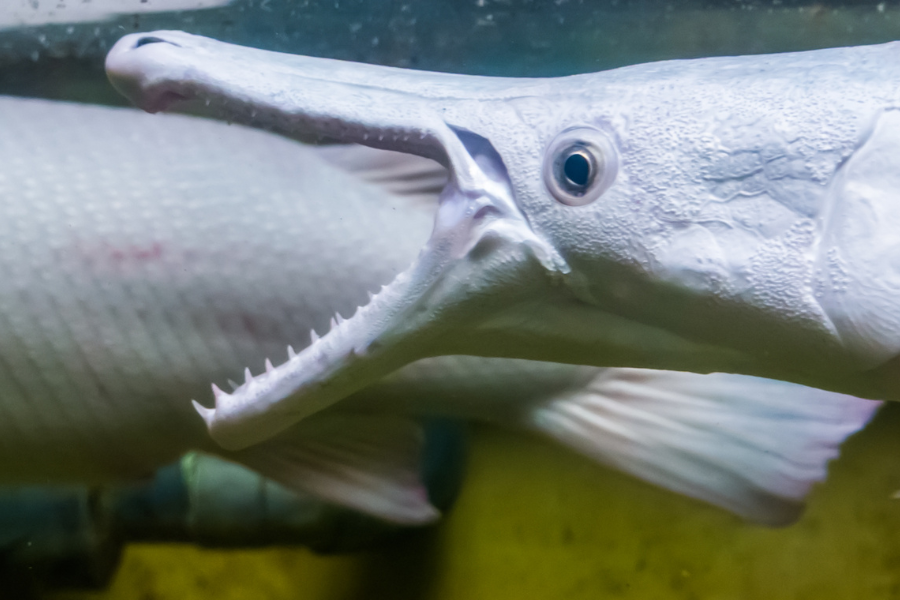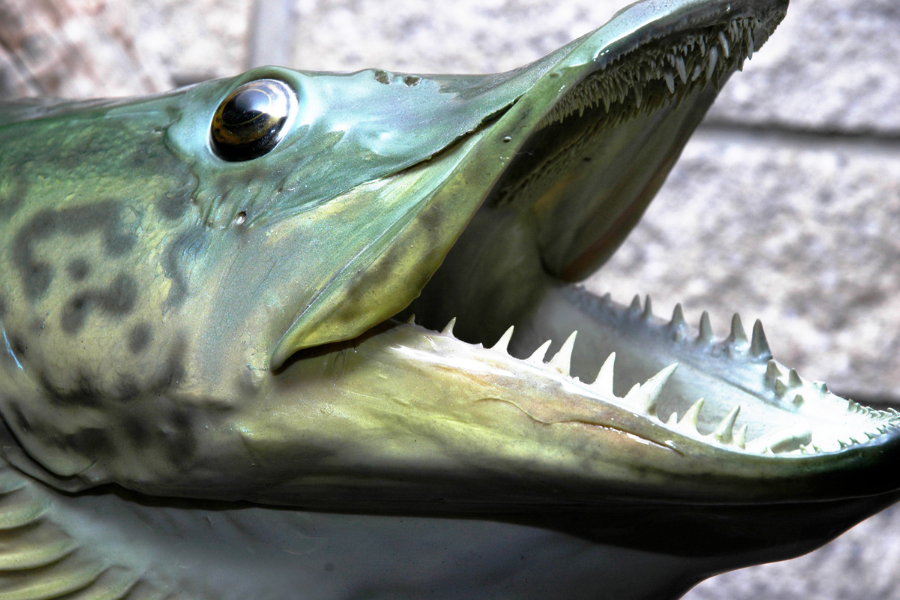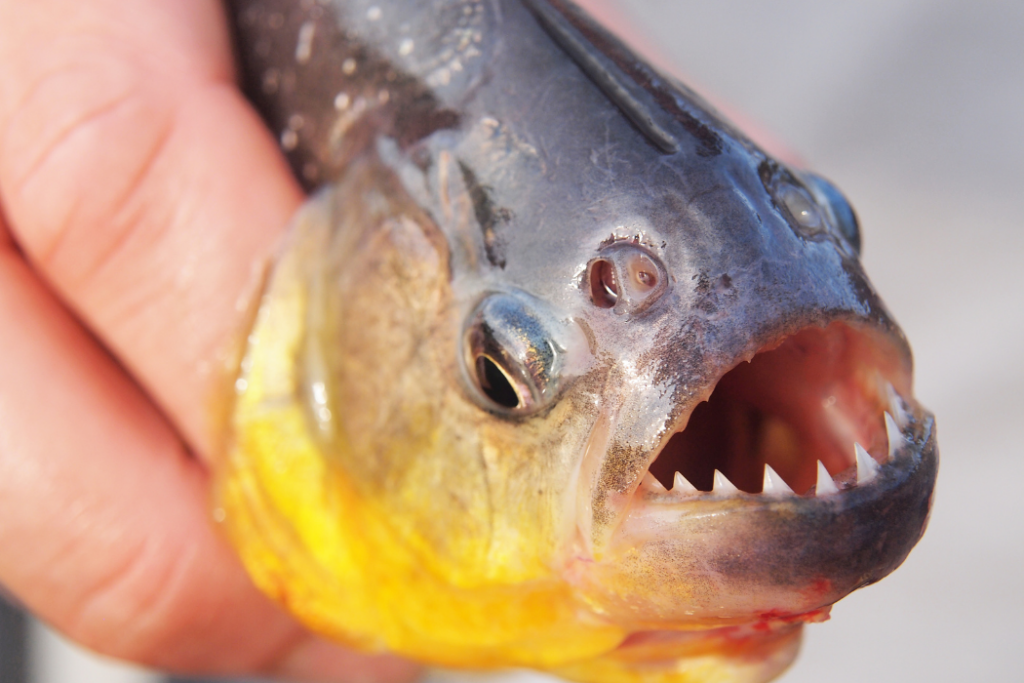8 Types of Fish With Brutally Sharp Teeth

Even though I knew that some fish have teeth, nothing prepared me for the first face-to-face encounter with a particularly toothy one. Honestly, the idea of unhooking such a specimen is not comforting at all.
Thankfully, except for a few, most freshwater game species lack teeth that can bite. However, anglers need to learn about this biting truth to stay prepared for any unfamiliar species that they might capture.
So here are 8 types of fish with teeth that you may encounter if you’re lucky… or unlucky. Depends how you look at it.
Before we get into it, you can check out Larry and DSC’s Director of Communication’s Conor Harrison as they join Guide Chris Moody at GarfishingAddiction.com as they chase down some Alligator Gar, once of the fish mentioned in this guide.
1. Payara (Dracula Fish)
This unique fish is known by many names which include “vampire fish”, “Dracula fish” “wolf fish”, “sabre tooth barracuda”, etc. The reason for these names is two scary fangs that rise sharply from their lower jaw. These are nightmarish teeth that any vampire would be proud of.
The Payara is a carnivorous fish found in South America, especially in the Amazon basin. A matured fish can be 3-feet in length. The dual fangs can be upto 6 inches in length and the Payara even have holes in the upper jaw that act as teeth housings.
Add to that a bony face and a lean body and you get a look perfect for a horror movie.
Not much research has been conducted on this unique species and a lot remains unknown. Payaras are aggressive by nature and feed on small and medium fishes.
While they will not suck your blood, many hunters have reported nicks and cuts while catching Payaras. They are usually caught with live bait and put up a tough fight before coming out of the water. The best way to handle them is by using nets.

2. Alligator Gar
The torpedo-shaped alligator gar may remind you of aquatic dinosaurs and can weigh over 100 pounds. It is classified as an endangered species in some states and is generally found in rivers, bays, lakes, and reservoirs.
Alligator gars have two distinct rows of teeth that are sharp enough to hold onto prey. The inner row is longer than the outer one. Plus, the sharp, bony scales on their body make handling the fish a tough task.
They mostly live on small fishes, small aquatic mammals, and birds. While their teeth appear frightening, alligator gars use these to hold onto their prey, the teeth are not designed for tearing off chunks of flesh.
But alligator gars are terrific fighters and show surprise bursts of energy. Once you have landed a gar, avoid the mouth while handling it. Best wear cut-resistant gloves and use long pliers for dehooking.
Some reports speak of alligator gar attacks on humans. However, experts mention that despite its scary appearance, the alligator gar is a docile fish that is not a threat to humans. They generally avoid humans who are stepping into their habitat.
3. Bowfin
While many anglers find bowfin to be a lot of fun, it is not a good fish to eat and remains less popular. Some say that fighting a mean bowfin while on a kayak is a truly nerve-rattling experience.
The colors on a male bowfin appear spectacular but make no mistake, they are notoriously aggressive and have powerful jaws. I have seen bowfins roll around when hooked and even breaking and bending the hooks by savage force.
They have sharp conical teeth that point inwards and can grip the prey effectively. Their food includes smaller fish, crayfish, mollusks, and insects. Primarily, bowfin are backwater fish and can live in water with low oxygen levels. At first glance, you might mistake it for a snakehead or eel because of the long dorsal fin.
Bowfins are drawn by the same type of baits used commonly for largemouths, like topwaters, crankbaits, and spinnerbaits. While they are not likely to chew your fingers off, use a durable landing net or a plastic fish grip to ensure safety. If you are using metal tools like a jaw spreader, be careful. A bowfin can deathroll and injure itself.

4. Esox (Pike, Pickerels, and Muskellunge)
While the lure of a trophy pike drives a lot of anglers, keep in mind that all members of this family have large pointed teeth The largest member of the Esox genus is the muskellunge and a full-grown fish can have more than 500 teeth! And a few of these can be around an inch in length.
These aren’t the type of pike and musky you find in your neighborhood resevoir or pond.
The sharp teeth make the members of the genus efficient ambush hunters. Their diet includes fish, frogs, and small animals. Even though humans are not a part of a muskie’s diet, there have been a few instances of musky attacks.
Besides, these fish also have sharp spines on the gills called gill rakers. Overall, these are not easy fish to handle, especially when deep-hooked. It is not unusual to have nasty punctures on your hand from pike teeth.
But in most cases, such injuries result from poor handling. Using rubber or latex-coated nets and jaw spreaders is a good idea to ensure safety. A fish grip will also give you better control of a thrashing pike.
Another option is to tag along a veteran and learn the right way of handling a pike by using the chin grip. That way you will be able to prevent the fish from thrashing around and causing any injury.
5. Lingcod
The Pacific lingcod has 500-plus teeth arranged in multiple rows that catch and shred prey. Some lingcods can lose an incredible number of 20 teeth per day on average and replace them. Combined with large eyes set on a big head they look ferocious and can grow around 60 inches in length.
Lingcods are fierce predators and voracious feeders. Thanks to their super sharp dental package, they are always ready to chomp down on small fish and live bait. Plus, they have remarkable jaw strength to bite down on armored crabs.
Be ready to grit your teeth while battling a lingcod as they put up a hard fight. That makes them a popular choice for many anglers. Hooking lingcods is not so easy, but if you manage it they are one of the tastiest fish you will catch.
Often, lingcods tend to grab the bait stubbornly even without biting the hook. So using a net or a fish gripper is necessary to secure the catch. Once you land the fish, handle it with caution and stay clear of the gaping mouth.
6. Bluefish
Bluefish have a single row of small teeth which are razor-sharp. While they may not look as menacing as some other fish with big teeth, Bluefish tend to bite out chunks of flesh from their prey. The jaw power of these fish is incredible. In my experience, they can easily bite off chunks from hard plastic baits.
It is not uncommon for large schools of Bluefish to attack anything they can feed on, including human swimmers. This may happen when they are in a feeding frenzy, also called the “bluefish blitz”. This behavior has earned them the name “marine piranha”.
Generally, Bluefish are attracted to shiny baits. Live or cut baits like mackerel, butterfish, and menhaden work well too. Pinning a large Bluefish down is not easy and it is best to handle bluefish once they have expended all their energy. But, they take a while to tire.
Deep cuts are not uncommon while dehooking bluefish. Frankly, I wouldn’t bring my hands too close to those sharp teeth. For safety, use spreaders or pliers to take out the hook.

7. Black Piranha
A black piranha is the undisputed champion of the Bite League. The unbelievable biting power comes from its oversized jaw muscles and superior jaw-closing mechanism. The bite force they can generate is around 320 newton (N), strong enough to bite off your fingers or toes. Amazingly, this is more force than the jaws of a monster Tyrannosaurus rex can generate!
No wonder President Theodore Roosevelt, in his 1914 book, Through the Brazilian Wilderness, describes these flesh-eaters as “They are the most ferocious fish in the world.” Black Piranhas use their nasty, razor-sharp teeth to snap at the prey and can bite through the bone. Their feeding patterns are opportunistic and include smaller fish and insects.
They are mostly found in the river systems in South America and the adult fish are between 8 to 16 inches in length. Piranhas will bite through wires, so using a wire leader is a must to catch them. They will shred soft plastics or bucktail jigs easily. Spoon baits are a better option.
Interestingly, piranhas can generate a barking sound when taken out of water. That can be interpreted as an “I might bite you,” warning. Be cautious and use pliers while handling this fish as they can inflict a serious bite.
8. Wolf Fish (Giant Trahira)
Wolf fish are found in the river systems of South America, mostly in Brazil, Suriname, and Guyana. This predatory fish is one of the most fierce-looking creatures you may come across. The sharp “canine” teeth give it the appearance of an ugly warrior and even though they rarely attack humans, they can cling to the victims like a dog.
Wolf fish are tough customers and have a nasty temperament, especially when they are hungry. The Trahira is the larger one, called “king of the wolf-fish” and can grow upto a size of 4 feet. However, there is a smaller species that move around in schools.
Wolf fish can be found in shallow creeks or rivers and you will need a robust setup to go after them. These fish are hard to catch and keep spinning and jumping around when hooked. Plus, their bony mouth makes it difficult for the hook to penetrate.
It goes without saying that handling wolf fish in the wrong way can cause injuries. So, use pliers or a set of jaw spreaders to avoid the teeth.
Final Thoughts
So these are some of the freshwater fish with teeth that can deliver a nasty bite. The good news is, unless you are stepping in their habitat the chances of being bitten are very low.
Hooking some of these fish can be challenging as they can test your angling skills. Compared to other freshwater species like bass, trout, or various types of catfish, catching these can be a more thrilling experience.
Landing one of these unique fish with teeth will allow you to take a close look at nature’s fascinating design. But make sure to exercise caution as those teeth can cut deep.

